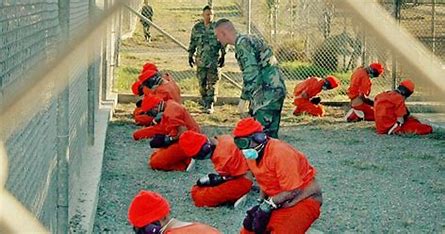
As of December 8, 2022, Guantánamo Bay detention facility – a prison offshore of American justice and built for those detained in this country’s never-ending Global War on Terror – has been open for nearly 21 years (or, to be precise, 7,627 days).
Thirteen years ago, I published a book, The Least Worst Place: Guantanamo’s First 100 Days. It told the story of the military officers and staff who received the prison’s initial detainees at that US naval base on the island of Cuba early in 2002. Like the hundreds of prisoners that followed, they would largely be held without charges or trial for years on end.
Ever since then, time and again, I’ve envisioned writing the story of its ultimate closure, its last days. Today, eyeing the moves made by the Biden administration, it seems reasonable to review the past record of that prison’s seemingly never-ending existence, the failure of three presidents to close it, and what if anything is new when it comes to one of the more striking scenes of ongoing injustice in American history.
When, in January 2002, those first planes landed at Guantánamo (which we came to know as Gitmo), the hooded, shackled, goggled and diapered prisoners in them were described by the Pentagon as “the worst of the worst.”
In truth, however, most of them were neither top leaders of al-Qaeda nor, in many cases, even members of that terrorist group. Initially housed at Camp X-Ray in open-air cages without plumbing, dressed in those now-iconic orange jumpsuits, the detainees descended into a void, with little or no prison policies to guide their captors.
When Brig-Gen Michael Lehnert, the man in charge of the early detention operation, asked Washington for guidelines and regulations to run the prison camp, Pentagon officials assured him that they were still on the drawing board, but that adhering in principle to the “spirit of the Geneva Conventions” was, at least, acceptable.
Those first 100 days left Gen Lehnert and his officers trying to provide some modicum of decency in an altogether indecent situation. For example, Lehnert and those close to him allowed one detainee to make a call to his wife after the birth of their child.
They visited others in their cells, talked with them and tried to create conditions that allowed for some sort of religious worship, while forbidding interrogations by officials from a variety of US government agencies without a staff member in the interrogation hut as well.
Against the wishes of Secretary of Defence Donald Rumsfeld and the Pentagon, a lawyer working with the general even called in representatives of the International Committee of the Red Cross.
By the end of March 2002, the US had installed prefab prisons at Guantánamo in which those detainees could be all too crudely housed and had brought in a new team of officers to oversee the operation while pulling Lehnert and his crew out.
The new leadership included people reporting directly to Rumsfeld as they put in place a brutal regime whose legacy has lasted, in all too many ways, to this day.
Despite Gen Lehnert’s efforts, in the nearly 21 years since its inception, Guantánamo has successfully left the codes of American law, military law, and international law in the dust, as it has morality itself in a brazen willingness to implement policies of unspeakable cruelty.
That includes both physical mistreatment and the limbo of allowing prisoners to exist in a state of indefinite detention. Most of its detainees were held without any charges whatsoever, a concept so contrary to American democracy and legality that it’s hard to fathom how such a thing could happen, no less how it’s lasted these 7,627 days.
As the 35 prisoners still in Guantánamo illustrate, no president has yet found a way to close that prison completely. George W. Bush, who opened it, did eventually acknowledge that it would be best to shut it down. As he put it to a German television audience in May 2006, “I very much would like to end Guantánamo. I very much would like to get people to a court.”
He was, however, anything but decisive on the subject. As he told a White House press conference that June, “I’d like to close Guantánamo, but I also recognise that we’re holding some people that are darn dangerous, and that we better have a plan to deal with them in our courts. And the best way to handle — in my judgment, handle these types of people is through our military courts.”
That month the Supreme Court invalidated the ad hoc military tribunals that had by then been formed at Gitmo and, in the fall of 2006, Congress passed the Military Commissions Act, formally creating the courts Bush had imagined.
Pointing out that shuttering the prison was “not as easy a subject as some may think on the surface,” the president then began pursuing another approach – namely, releasing uncharged prisoners and returning them to their home countries or transferring them elsewhere. And his administration did, in the end, release about 540 of the 790 prisoners held there. Gitmo accepted its last prisoner in March 2008.
Meanwhile, a 2008 Supreme Court ruling granting detainees the right to challenge their detention by filing habeas corpus petitions in federal court opened a new path toward future freedom. Twenty-three of those detainee petitions were granted before Bush left office, but the prison, of course, remained open.
Barack Obama initially signalled his desire to close Guantánamo on the campaign trail and then, in one of his first acts as president, issued an executive order calling for it to be shut down within a year.
“If any individuals covered by this order remain in detention at Guantánamo at the time of closure of those detention facilities,” it read, “they shall be returned to their home country, released, transferred to a third country or transferred to another United States detention facility in a manner consistent with law and the national security and foreign policy interests of the United States.”
With new energy, the Obama administration plunged ahead on the two fronts Bush had half-heartedly pursued: establishing military commissions and transferring certain prisoners directly to their home countries or others willing to accept them.
On Obama’s watch, a reformed version of the Guantánamo tribunals was authorised by the passage of the 2009 Military Commissions Act, resolving five cases, all with guilty pleas. In addition, his administration edged toward closure by transferring nearly 200 more prisoners to willing countries in a vigorous effort over the final year and a half of his presidency.
Still, he encountered unanticipated opposition within Congress. Although the military commissions did start anew under Obama, so many years later, their trial of the five prisoners alleged to have been actual 9/11 co-conspirators has still not been scheduled.
In addition, under Obama, numerous habeas corpus petitions were filed in federal court, often falling victim to defeat in appellate courts. As Shayana Kadidal, the Center for Constitutional Rights’ senior managing attorney for Gitmo litigation, summed it up at Just Security, “By 2011, the then sharply conservative DC Circuit had rendered it more or less impossible for detainees to prevail on their habeas petitions.”
Obama’s team did seem to add a new possibility for aiding the closure process by transferring one detainee to federal court for trial on terrorism charges.
In 2010, Ahmed Ghailani stood trial in New York City for participating in the bombings of two US embassies in East Africa. He was found guilty and sentenced to life in prison on US soil. But in the end, the trial proved fraught with problems, including the fact that the defendant was acquitted on 284 of 285 charges and so it would prove to be not just the first but the last such trial.
In fact, in the 2011 National Defence Authorization Act, Congress included a ban on the transfer to the United States of any further Gitmo detainees for any reason whatsoever.
- A TomDispatch report











